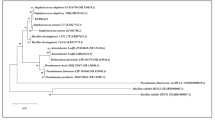Abstract
A sequencing batch reactor (SBR) was used to remove phosphate in biological wastewater treatment as an alternative to the activated sludge process, in order to improve the low removal efficiency of phosphate and the operational instability. After a cycle of 2 h anaerobic and 4 h aerobic conditions, phosphate removal was optimized. The removal efficiencies of 5 and 50 mg phosphate l−1 by Staphylococcus auricularis under repeated anaerobic and aerobic conditions were above 90%. These results showed that a long adaptation time, one of the major problems in biological phosphate removal process, was overcome by SBR.
Similar content being viewed by others
References
Andrew DE (1995) Ascorbic acid method. In: American Public Health Association, eds. Standard Methods for the Examination of Water and Wastewater, 19th edn. Maryland: United Book Press, pp. 106–114
Artan N, Tasli R, Ozgur N, Orhon D (1998) The fate of phosphate under anoxic conditions in biological nutrient removal activated sludge system. Biotechnol. Lett. 20: 1085–1090
Arvin E, Kristensen GH (1983) Phosphate precipitation in biofilms and flocs. Wat. Sci. Technol. 15: 65–85
Fukase T, Shibata M, Miyaji Y (1985) The role of an anaerobic stage in biological phosphorus removal. Wat. Sci. Technol. 17: 69–80
Lee YU (1995) Removal technology of nitrogen and phosphorus Kor. J. Environ. Technol. 7: 24–35
Marcia HB, Torabian A (1981) The effect of the COD: P ratio on laboratory activated sludge systems. Wat. Res. 15: 999–1004
Murakami A (1987) The characteristics of simultaneous removal of BOD, nitrogen and phosphorus by batch activated sludge process. Jap. J. Soc. Wat. Environ. 10: 187–190
Nakamura K, Masuda K, Mikami E (1991) Isolation of a new type of polyphosphate accumulating bacterium and its phosphate removal characteristics. J. Ferment. Bioeng. 71: 258–263
Oliver JH, Chang CH (1987) Kinetics of growth and phosphate uptake in pure culture studies of Acinetobacter species. Biotechnol. Bioeng. 29: 819–831
Qin Y, Ohtake H, Toda K (1988) Phosphorus removal by pure and mixed cultures of microorganisms. J. Ferment. Technol. 66: 207–212
Smolder GJF, Meij J, Loosdrecht MCM, Heijnen JJ (1994) Stoichiometric model of the aerobic meabolism of the biological phosphorus removal process. Biotechnol. Bioeng. 44: 837–848
Suresh N, Warburg R, Timmerman M (1985) New strategies for the isolation of microorganisms responsible for phosphate accumulation Wat. Sci. Technol. 17: 43–56
Author information
Authors and Affiliations
Rights and permissions
About this article
Cite this article
Choi, S.S., Yoo, Y.J. Removal of phosphate in a sequencing batch reactor by Staphylococcus auricularis. Biotechnology Letters 22, 1549–1552 (2000). https://doi.org/10.1023/A:1005628816350
Issue Date:
DOI: https://doi.org/10.1023/A:1005628816350




